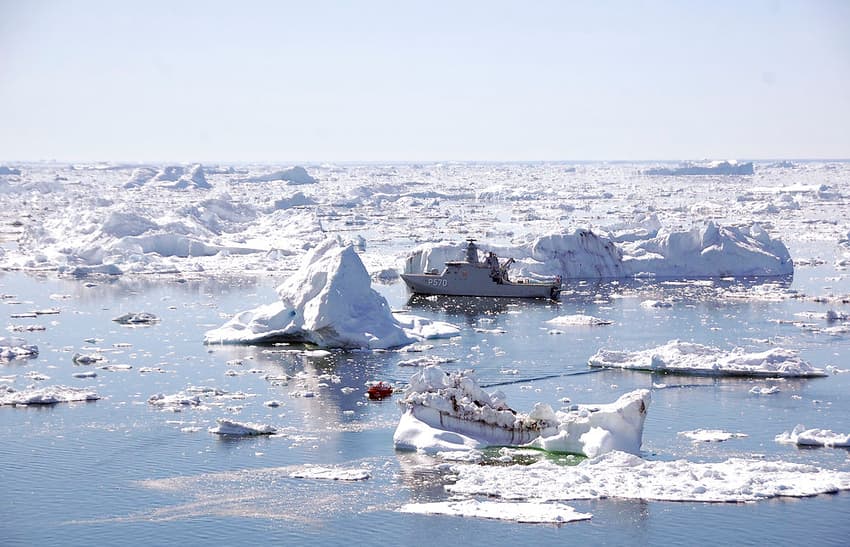Greenland's ice is melting at increasing speed: analysis

The rate at which the inland ice in Greenland is melting increased fourfold from 2003 to 2013.
A new and comprehensive study found that 111 cubic kilometres of Greenland's inland ice disappeared in 2003. Ten years later, that figure had risen to 428 cubic kilometres.
That corresponds to a fourfold increase within the last 10 years, DR reports.
Shfaqat Abbas Khan, a researcher at the Technical University of Denmark, contributed to the study.
"It is surprising that the ice is also melting in southwestern Greenland. In the future, melting water from that area is likely to make a major contribution to global sea levels," Khan said to DR.
Up to now, focus has mainly been on the northwest and south-eastern part of Greenland, he added.
The melting of the glaciers is caused in part by rising sea temperatures, whereby glaciers are meeting an increasingly warmer sea. But this doesn't explain why the ice is melting in southwestern Greenland, where there are fewer glaciers.
But large amounts of ice are also disappearing from this part of the country, researchers concluded. This means that areas without glaciers - where the ice only melts a few summer months a year - also contribute to changes in sea level because the temperature in the air is rising.
"This means that the ice in those areas is contributing to the sea level to the same extent - or to an even greater extent - as in the areas where glaciers are located," Khan said.
Researchers working on the study analyzed satellite images of Greenland and compared the results with measurements of the bedrock in Greenland.
The comparison was applied to data from the period 2003 to 2016.
Here, they saw that the meltdown accelerated year by year, with the exception of a period of 12-18 months beginning in mid-2013.
"This shows that it is necessary to observe climate change over a long period of time in order to be able to accommodate the variations in the weather that occur naturally," Sebastian Mernild, a climate researcher at the Nansen Environmental and Remote Sensing Center, told DR.
The melting accelerated again in 2014, and Khan estimates that rate will be even greater in the future.
"As the temperature in the atmosphere continues to rise, we will see increased melting in Greenland," he said.
READ ALSO: Denmark’s bacon exports damaging environment: Greenpeace
Comments
See Also
A new and comprehensive study found that 111 cubic kilometres of Greenland's inland ice disappeared in 2003. Ten years later, that figure had risen to 428 cubic kilometres.
That corresponds to a fourfold increase within the last 10 years, DR reports.
Shfaqat Abbas Khan, a researcher at the Technical University of Denmark, contributed to the study.
"It is surprising that the ice is also melting in southwestern Greenland. In the future, melting water from that area is likely to make a major contribution to global sea levels," Khan said to DR.
Up to now, focus has mainly been on the northwest and south-eastern part of Greenland, he added.
The melting of the glaciers is caused in part by rising sea temperatures, whereby glaciers are meeting an increasingly warmer sea. But this doesn't explain why the ice is melting in southwestern Greenland, where there are fewer glaciers.
But large amounts of ice are also disappearing from this part of the country, researchers concluded. This means that areas without glaciers - where the ice only melts a few summer months a year - also contribute to changes in sea level because the temperature in the air is rising.
"This means that the ice in those areas is contributing to the sea level to the same extent - or to an even greater extent - as in the areas where glaciers are located," Khan said.
Researchers working on the study analyzed satellite images of Greenland and compared the results with measurements of the bedrock in Greenland.
The comparison was applied to data from the period 2003 to 2016.
Here, they saw that the meltdown accelerated year by year, with the exception of a period of 12-18 months beginning in mid-2013.
"This shows that it is necessary to observe climate change over a long period of time in order to be able to accommodate the variations in the weather that occur naturally," Sebastian Mernild, a climate researcher at the Nansen Environmental and Remote Sensing Center, told DR.
The melting accelerated again in 2014, and Khan estimates that rate will be even greater in the future.
"As the temperature in the atmosphere continues to rise, we will see increased melting in Greenland," he said.
READ ALSO: Denmark’s bacon exports damaging environment: Greenpeace
Join the conversation in our comments section below. Share your own views and experience and if you have a question or suggestion for our journalists then email us at [email protected].
Please keep comments civil, constructive and on topic – and make sure to read our terms of use before getting involved.
Please log in here to leave a comment.